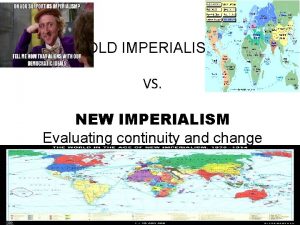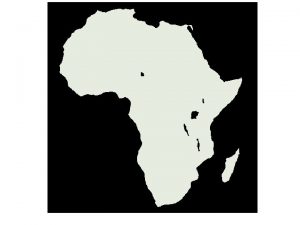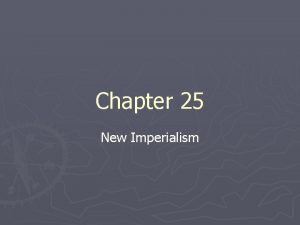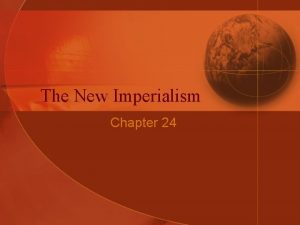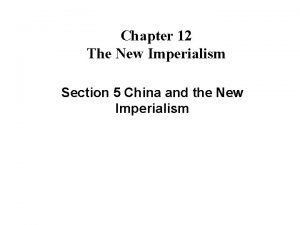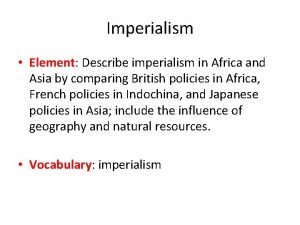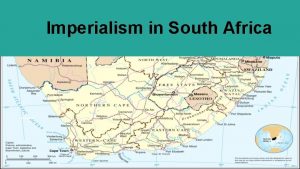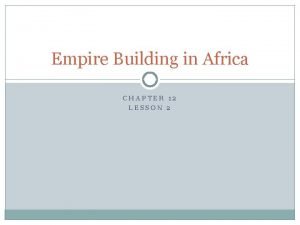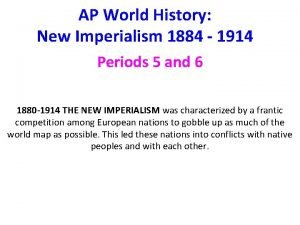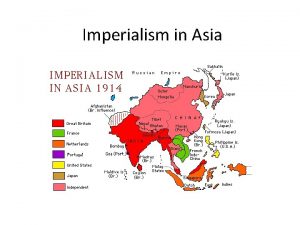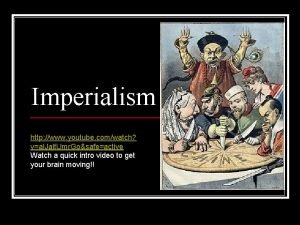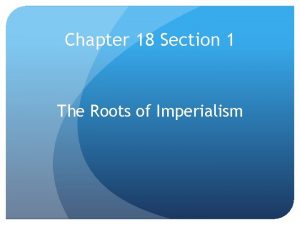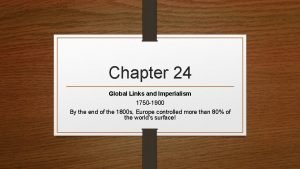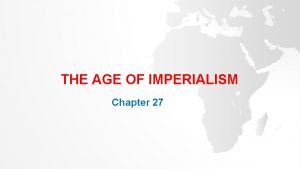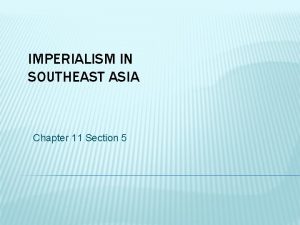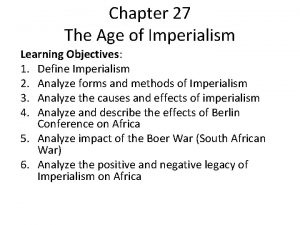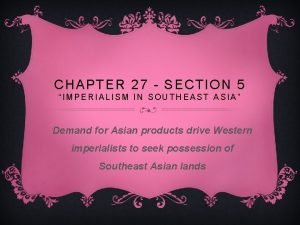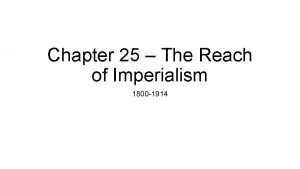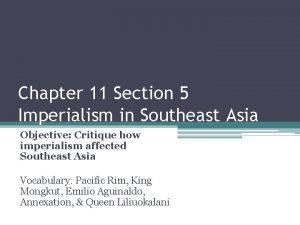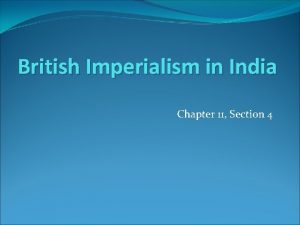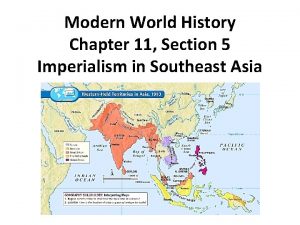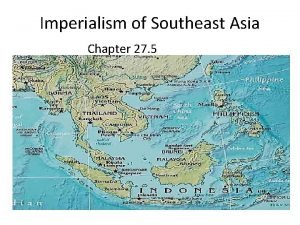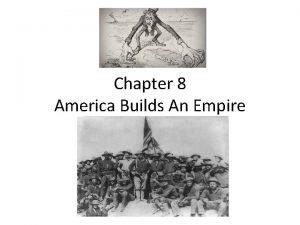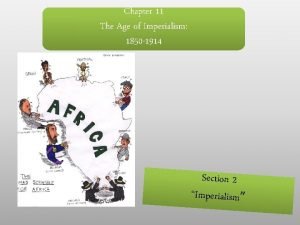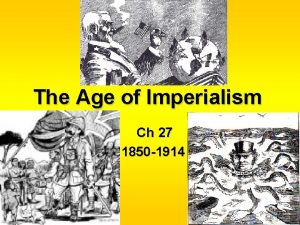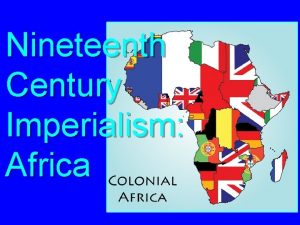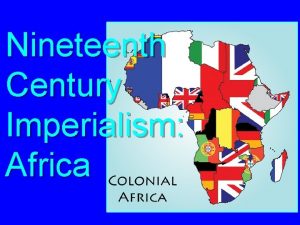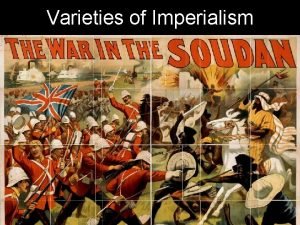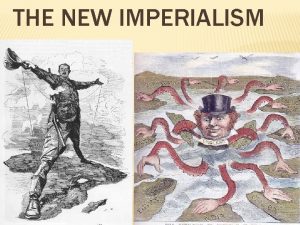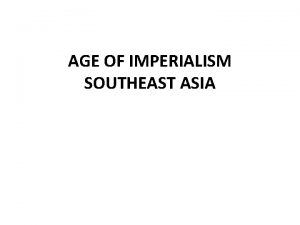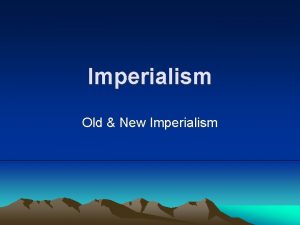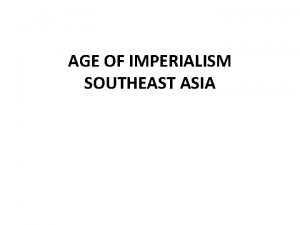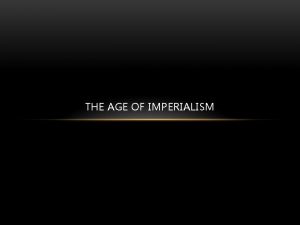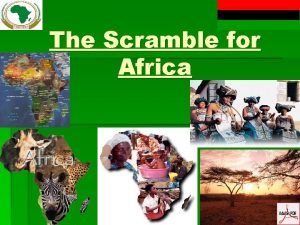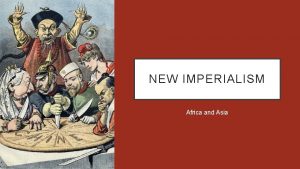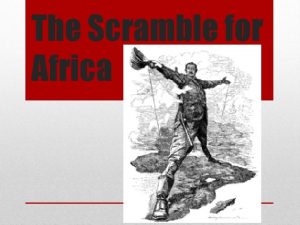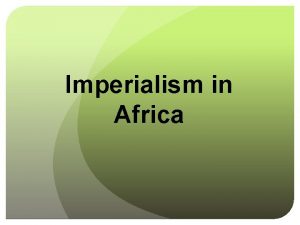Chapter 26 The New Imperialism in Africa and

























































- Slides: 57

Chapter 26 The New Imperialism in Africa and Southeast Asia, 1830– 1914 Copyright © 2017 Cengage Learning. All Rights Reserved.

Learning Objectives (Slide 1 of 4) ▪ ▪ Recognize the importance of the diplomacy of King Khama III in helping to establish the Bechuanaland as a British protectorate Define the new imperialism and outline its main causes Copyright © 2017 Cengage Learning. All Rights Reserved.

Learning Objectives (Slide 2 of 4) ▪ ▪ Discuss how the Europeans took advantage of the internal tensions between African chiefdoms in order to establish political, military, and economic control Summarize the different conditions, governments, and societies in western and southern Africa Copyright © 2017 Cengage Learning. All Rights Reserved.

Learning Objectives (Slide 3 of 4) ▪ ▪ ▪ Explain how Africans responded to European imperialism, along with their efforts to militarily resist invasion and occupation Identify the main outcomes of the New Imperialism in Southeast Asia Describe the Dutch and French efforts at imperialism in Southeast Asia and what they hoped to gain from the region Copyright © 2017 Cengage Learning. All Rights Reserved.

Learning Objectives (Slide 4 of 4) ▪ ▪ ▪ Analyze the connections and comparisons that can be made between Africa and Southeast Asia in the late nineteenth century Discuss rubber as a case study of how natural resources, technology, and the profit motive could drive imperialism Describe the policies by which Ethiopia and Siam remained free of European imperialism Copyright © 2017 Cengage Learning. All Rights Reserved.

Imperialism: Crash Course World History #35

King Khama III was king of the Bangwato, a Tswana-speaking southern African group. His successful diplomacy helped establish the Bechuanaland protectorate, putting the Bangwato and other kingdoms under British rather than South African rule. Khama: The Great! Copyright © 2017 Cengage Learning. All Rights Reserved.

The Travels of King Khama Copyright © 2017 Cengage Learning. All Rights Reserved.

The New Imperialism (Slide 1 of 2) ▪ King Khama III was king of the Bangwato people of southern Africa ▪ ▪ ▪ In 1895, Khama and two neighboring kings went on a long diplomatic mission to London White settlers were moving farther northward into South Africa Khama wanted the British government to proclaim a protectorate Copyright © 2017 Cengage Learning. All Rights Reserved.

The New Imperialism (Slide 2 of 2) ▪ The colonial secretary argued in Khama’s favor ▪ ▪ ▪ Khama also met with Queen Victoria Ultimately, Botswana was spared the apartheid that was instituted in South Africa in the twentieth century After 1870, Africans confronted “a multitude of white men” ▪ Era of New Imperialism had begun Copyright © 2017 Cengage Learning. All Rights Reserved.

Political and Economic Motives (Slide 1 of 4) ▪ Unification of Germany in 1871 precipitated Germany being the newest world power and the fastest-growing industrial economy ▪ ▪ Bismarck was concerned that rapid industrialization and urbanization was leading to politicization of the working class By creating an empire, Bismarck hoped to distract the workers with nationalism Copyright © 2017 Cengage Learning. All Rights Reserved.

Political and Economic Motives (Slide 2 of 4) ▪ French were also concerned with restoring their national glory after their defeat to Germany in 1871 ▪ Imperial expansion in Africa and Southeast Asia made the Third Republic seem more legitimate Copyright © 2017 Cengage Learning. All Rights Reserved.

Political and Economic Motives (Slide 3 of 4) ▪ Britain already had a large world empire, with maritime trade, domination of world finance, and early industrialization ▪ ▪ Early territories included India and South Africa Rise of a German empire pushed Britain to expand her empire, further Copyright © 2017 Cengage Learning. All Rights Reserved.

Political and Economic Motives (Slide 4 of 4) ▪ Economic factors also pushed the new imperialism ▪ The Second Industrial Revolution led corporations to invest money in new technologies ▪ ▪ The new imperialism revived mercantilist economic policies Countries attempted once again to have exclusive access to resources AP Euro: Second Industrial Revolution Copyright © 2017 Cengage Learning. All Rights Reserved. The Second Industrial Revolution

Ideology and Personal Ambition (Slide 1 of 4) ▪ Dominant ideology in Europe was Social Darwinism, the idea that humanity comprises clearly demarcated racial groups with a hierarchy of ability ▪ Europeans believed that they were the superior race and that justified their colonial control over other races Indigenous Assimilation & Social Darwinism (per "Home": 2015) Copyright © 2017 Cengage Learning. All Rights Reserved.


Ideology and Personal Ambition (Slide 2 of 4) ▪ Christian missionaries also practiced Social Darwinism Stanley and Livingstone Movie Clip Dr Livingstone, I Presume 2 ▪ Missionaries believed in the spiritual capacities of African and native peoples ▪ The dream of David Livingstone, the great Scottish missionary, was to have African Christians take over positions of church leadership ▪ In 1864, Samuel Ajayi Crowther fulfilled Livingstone’s goal; became the first African bishop in the Church of England Copyright © 2017 Cengage Learning. All Rights Reserved.


Ideology and Personal Ambition (Slide 3 of 4) ▪ ▪ Racism forced Crowther into retirement, and an English bishop replaced him Henry Morton Stanley represented the new imperialist views of Africans ▪ ▪ Stanley was convinced that Africans were savages and could not be “civilized” Stanley formed an alliance with King Leopold II of Belgium to claim the region around the Congo River MTSAU Ep 11, 24 -34 King Leopold's Ghost - Trailer Copyright © 2017 Cengage Learning. All Rights Reserved. Congo-The Brutal History

Ideology and Personal Ambition (Slide 4 of 4) ▪ Otto von Bismarck thought that Leopold’s imperialism would destabilize the balance of power ▪ ▪ Summoned the other colonial powers to a Berlin Conference in 1884 Determined that the boundaries of European colonies in Africa would only count if the country established effective occupation of the colony A Brief History Of European Colonization in Africa Copyright © 2017 Cengage Learning. All Rights Reserved.

Africa and the New Imperialism ▪ Western and eastern Africa ▪ European merchants purchased palm oil, needed as an industrial lubricant, from West African merchants ▪ ▪ In the 1820 s, many West African merchants became wealthy in the palm oil trade 1868: Essay by John Africanus Horton ▪ Called for African kingdoms to reform themselves; incorporate Western constitutional practices Copyright © 2017 Cengage Learning. All Rights Reserved.

Africa, 1878 and 1914 Copyright © 2017 Cengage Learning. All Rights Reserved.

Western and Eastern Africa (Slide 1 of 3) ▪ In 1874, the British attacked the Asante kingdom ▪ ▪ Asante armies were outnumbered and outgunned by the British Muslim reformers had created a string of new states by the early 1800 s ▪ Throughout the nineteenth century, West African Muslim populations gained large numbers of new adherents Copyright © 2017 Cengage Learning. All Rights Reserved.

Western and Eastern Africa (Slide 2 of 3) ▪ In the 1870 s, the jihadists and the French came into conflict ▪ Muslim resistance to the French was led by Samori Toure ▪ ▪ ▪ Led a jihad against Muslims and unbelievers Overwhelmed, Samori retreated to the east and launched a guerilla war In 1893, Samori was captured and exiled ▪ French controlled from the Senegal to the Niger Rivers Copyright © 2017 Cengage Learning. All Rights Reserved.

Western and Eastern Africa (Slide 3 of 3) ▪ British tried to stop the French by taking over the Sokoto caliphate ▪ ▪ The Sokoto had become decentralized with the death of Fodio British took over the region (now northern Nigeria) by attacking each emir individually ▪ ▪ Emirs could not withstand British rifles, machine guns, and cannons In West Africa, lack of alliances among African peoples facilitated European imperialism Copyright © 2017 Cengage Learning. All Rights Reserved.

Edward Wilmot Blyden Father of modern Pan-Africanism, Blyden moved from the Virgin Islands to West Africa, advocating political, economic, and cultural cooperation between American blacks and continental Africans. Above all, Blyden was an educator who stressed the importance of black empowerment and black self-confidence. Copyright © 2017 Cengage Learning. All Rights Reserved.

Southern Africa (Slide 1 of 7) ▪ Before the Dutch settled at Cape Town, the Bantu-speaking peoples of southern Africa had centralized chiefdoms ▪ These people were farmers, herders, and ironworkers Late 1700 s: Drought encouraged smaller chiefdoms to come together to secure water resources A brief history of the Zulu nation 200 years on ▪ ▪ Shaka created the most successful of these combined states, the Zulu Empire Copyright © 2017 Cengage Learning. All Rights Reserved. Shaka's first battle

Southern Africa (Slide 2 of 7) ▪ The Zulu Empire was built by conquering neighboring chiefdoms, a process known as mfecane, or “crushing” ▪ ▪ Many chiefdoms were violently absorbed into the Zulu empire; some voluntarily submitted British had taken over Cape Town from the Dutch during the Napoleonic Wars Copyright © 2017 Cengage Learning. All Rights Reserved.

Southern Africa (Slide 3 of 7) ▪ Descendants of earlier Dutch and French colonists, the Boers, sought land for further expansion ▪ Moved into territories temporarily depopulated in the wake of Zulu warfare ▪ ▪ Boers and the British overwhelmed the Xhosa and other African chiefdoms 1850 s: Europeans unintentionally introduced a cattle disease ▪ Xhosa then slaughtered the rest, the Xhosa Cattle Killing (1856– 1857) Copyright © 2017 Cengage Learning. All Rights Reserved. Nongqawuse: Prophetess of Doom!

Southern Africa (Slide 4 of 7) ▪ Over one hundred thousand Africans were killed ▪ ▪ Survivors were incorporated into Britain’s Cape Colony The Zulu remained politically independent until the 1870 s when diamonds and gold were discovered ▪ In 1879, the British demanded that the Zulu king, Cetshwayo, disband his army Copyright © 2017 Cengage Learning. All Rights Reserved.

Southern Africa (Slide 5 of 7) The Scramble for Africa - Timelines. tv History of Britain C 08 ▪ Cecil Rhodes was a British mining entrepreneur and advocated for a larger British Empire ▪ ▪ Rhodes invaded the Boer Republic, where gold was located South African War (1899– 1902) was the first twentieth-century war ▪ British won the war and created the Union of South Africa (1910) Copyright © 2017 Cengage Learning. All Rights Reserved.

Southern Africa (Slide 6 of 7) ▪ Both Boer and British forces were unified under the constitution Britain and the Boer War ▪ ▪ South Africa became a self-governing dominion in the British empire, like Canada In 1913, the all-white South African parliament passed the Native Land Act ▪ ▪ Limited Africans to living on native reserves The goal was to strip indigenous communities of their agricultural self-sufficiency laying the foundations for apartheid Copyright © 2017 Cengage Learning. All Rights Reserved. south african apartheid explained by official of native Affairs department

Southern Africa (Slide 7 of 7) ▪ Khama was successful in negotiating some autonomy for his people ▪ ▪ Bangwato people were governed by the British Colonial Office and not by the South African parliament In German Southwest Africa, the German ordered that the Herero be driven into the Kalahari Desert and prevented from returning ▪ Tens of thousands of them died in the century’s first genocide Namibia's forgotten Herero people waiting for genocide apology Copyright © 2017 Cengage Learning. All Rights Reserved.

Cecil Rhodes The most important of Victorian imperialists, Cecil Rhodes dreamed of British imperial control of eastern and southern Africa “from Cape to Cairo. ” Combining political and economic clout, Rhodes was prime minister of the Cape Colony, founder of the De Beers diamond syndicate, owner of some of the world’s richest gold mines, and head of the British South Africa Company. He later endowed the Rhodes Scholarship program to bring elite Americans of British descent to Oxford University in England so that the United States might share Britain’s imperial purpose. Cecil Rhodes' Dream of Conquest - Empire Episode 5 - BBC One Copyright © 2017 Cengage Learning. All Rights Reserved.

African Resistance to Conquest (Slide 1 of 6) ▪ 1880– 1900: European powers occupied and partitioned Africa ▪ In spite of European technological superiority, Africans fought back ▪ Financed by French and English capital, the Suez Canal became the main shipping route between Europe and Asia ▪ After a rebellion against Britain concerning the Canal, the British came to dominate Egypt History of Singapore - Suez Canal (Discovery Channel Documentary) Copyright © 2017 Cengage Learning. All Rights Reserved.

African Resistance to Conquest (Slide 2 of 6) ▪ In the Upper Nile Valley, Britain faced another threat in Sudan ▪ A cleric named Muhammad Ahmad proclaimed himself to be the Mahdi, the “guided one” He declared a jihad against Egypt and took the strategic city of Khartoum in 1884, killing the British commander Khartoum - The Mad Mahdi ▪ ▪ Ahmad died in 1885 of typhus; his forces scattered Al Mahdi and Britian 1/6 Copyright © 2017 Cengage Learning. All Rights Reserved.

African Resistance to Conquest (Slide 3 of 6) ▪ The Mahdi jihad movement was revived in the 1890 s ▪ ▪ ▪ To prevent any expansion of the French and German into the Nile Valley, the British were determined to occupy the entire region The new Mahdi’s forces and the British met at the Battle of Omdurman At least 10, 000 Mahdist soldiers were killed Copyright © 2017 Cengage Learning. All Rights Reserved.

African Resistance to Conquest (Slide 4 of 6) ▪ The British decided to “effectively occupy” the coastal territories in 1896 to finally put an end to Asante independence ▪ The British governor demanded that the golden stool, a sacred symbol, be brought to him ▪ The Asante rebelled; however, the War of 1900 was a military defeat for the Asante, but it caused later British governors to acknowledge Asante traditions Copyright © 2017 Cengage Learning. All Rights Reserved.

African Resistance to Conquest (Slide 5 of 6) ▪ British also faced stiff resistance in the southern African kingdom of the Ndebele ▪ ▪ The Ndebele were absorbed into the British colony of Rhodesia after losing two wars of resistance in the 1890 s 1905: Maji Revolt in German East Africa was led by Kinjekitile, a religious prophet German East Africa - World War 1 Colonial Warfare I THE GREAT WAR Special ▪ Germans suppressed the revolt, but also stopped forcing the people to grow cotton Copyright © 2017 Cengage Learning. All Rights Reserved.

African Resistance to Conquest (Slide 6 of 6) ▪ Imperial powers consistently demeaned Africans ▪ ▪ Displayed “natives” as a curiosity at Western expositions Worst excess came in 1906, when a Central African named Ota Benga was displayed in a cage at the Bronx Zoo ▪ ▪ Ota Benga: The Man Who Was Kept in a New York Zoo He later committed suicide The disrespect and cruelty fostered by such racism long endured Copyright © 2017 Cengage Learning. All Rights Reserved.

The New Imperialism in Southeast Asia, Austronesia, and the Pacific ▪ Mainland Southeast Asia ▪ French occupied Vietnam – displaced its imperial rulers, who had modeled themselves on the Ming dynasty ▪ ▪ In 1862, French were given control of the Mekong River and Saigon ▪ By 1884, French were in control of all of Vietnam French Colonisation - The Vietnam War French took over Cambodia and Laos; combined these territories into the Federation of Indochina Copyright © 2017 Cengage Learning. All Rights Reserved.

The New Imperialism in Southeast Asia, 1910 Copyright © 2017 Cengage Learning. All Rights Reserved.

Mainland Southeast Asia ▪ Burma was incorporated into the British empire in stages Colonial Britain Ravishing Burma's Lands (War Documentary) - Real Stories ▪ 1886: British forces invaded from India and took the capital of Mandalay ▪ ▪ Built railroads to the rich timber resources of the Burmese jungles By 1869, British merchants wanted the rich tin resources of the Malay Peninsula ▪ Indigenous rulers remained in place but power was in the hands of Europeans Copyright © 2017 Cengage Learning. All Rights Reserved. [Malaysia] Great Britain takes Malaya

French Colonialism in Indochina Like other European colonialists, the French argued that they were developing their imperial territories for the good of their subjects through both a “civilizing” cultural mission and economic development projects such as road building. As this photograph from Southeast Asia indicates, however, it was the “natives” who did most of the work and their colonial overlords who grabbed the lion’s share of profit. Copyright © 2017 Cengage Learning. All Rights Reserved.

Insular Southeast Asia, Austronesia, and the Pacific (Slide 1 of 2) ▪ After disbanding the Dutch East India Company in 1799, the Dutch imposed harsh economic conditions Journey From Above - Aerial Video Indonesia ▪ ▪ ▪ In 1830, the Dutch forced farmers of Java to convert their fields from rice to sugar The Dutch then bought the sugar at a low price and exported it to other countries at a high profit Originally, the Dutch had worked through local sultans in Java and Sumatra Indonesians to receive Dutch apology Copyright © 2017 Cengage Learning. All Rights Reserved.

Insular Southeast Asia, Austronesia, and the Pacific (Slide 2 of 2) ▪ United States was also creating its own imperial power in Asia ▪ ▪ 1898: U. S. annexed the Hawai’ian Islands 1898– 1900: U. S. fought the Spanish. American War ▪ Led to the acquisition of the Philippines in 1899 Meet The Native Hawaiians Fighting U. S. Occupation | Direct From With Dena Takruri AJ+ Duterte: Philippines is not US Colony - We American Imperialism: 1890 -1917 WILL SURVIVE EVEN IN HUNGER Copyright © 2017 Cengage Learning. All Rights Reserved.

The West African Republic of Liberia was founded in 1847 by freed American slaves. An earlier version of the flag had a cross rather than a star in the upper left. Monkey Meat and the Ebola Outbreak in Liberia Ebola Virus: Film reveals scenes of horror in Liberia - BBC News Copyright © 2017 Cengage Learning. All Rights Reserved.

The Flag of Ethiopia This flag, first used in 1897, features the “Lion of Judah” as a symbol for Ethiopia. Red stands for power and faith; yellow for peace, wealth, and love; and green for land hope. Copyright © 2017 Cengage Learning. All Rights Reserved.

One of Siam’s Flags This flag dates from 1891. One of several different flags from Siam, it was flown above the palace only when the king was present. At the center is the royal coat of arms, with a trident and golden crown above. Later, the flag of Thailand evolved to emphasize national rather than royal identity, with horizontal stripes of red, white, and blue. Copyright © 2017 Cengage Learning. All Rights Reserved.

The Hawai’ian Flag This flag was commissioned by Kameha the Great, the first Hawai’ian to unify the islands, in 1816, and it flew until 1893. The eight bars represent the major Hawai’ian Islands, and the British Union Jack reflects the attempts of Hawai’ian monarchs to use an alliance with Britain as protection against the United States and other imperialist powers. This is the current state flag of Hawai’i. Copyright © 2017 Cengage Learning. All Rights Reserved.

The Cherokee Flag After the U. S. government forcibly moved the Cherokee people to Oklahoma, the nation adopted a constitution to mark their quest for sovereignty in their new home. The date on this flag commemorates that constitution. Each of the seven yellow stars represents one of the original Cherokee clans; the black star represents those who lost their lives on the “Trail of Tears. ” Copyright © 2017 Cengage Learning. All Rights Reserved.

Case Studies in Imperialism ▪ A case study of the New Imperialism: Rubber Charles Goodyear and the invention of Rubber ▪ Rubber was used in the early nineteenth century for conveyor belts in factories and waterproof clothing ▪ ▪ Much rubber came from the Brazilian Amazon where rubber plantations took the place of farms and forests In the Congo, King Leopold forced the natives to harvest rubber while committing humanitarian atrocities Copyright © 2017 Cengage Learning. All Rights Reserved.

Torture in King Leopold’s Congo Here two victims of King Leopold’s policies, Mola and Yoka, display their mutilated limbs. The hands of Mola were eaten by gangrene after his hands were tied too tightly by Leopold’s agents. Yoka’s right hand was cut off by soldiers who planned to receive a bounty at headquarters by using the hand as proof of a kill. Once the world learned about this extreme violence, humanitarian voices were raised against Leopold. Copyright © 2017 Cengage Learning. All Rights Reserved. King Leopold and the Congo Genocide

Enduring Monarchies: Ethiopia and Siam (Slide 1 of 2) ▪ Ethiopia decided to modernize and reform its government, in order to prevent a European takeover ▪ ▪ King Menelik II took measures to strengthen the state First European power to attempt to conquer Ethiopia was Italy, weakest of the European imperial powers Zewde Nesibu: The servant of Emperor Menelik II & oldest man with 128 yrs Copyright © 2017 Cengage Learning. All Rights Reserved. Menelik II

Enduring Monarchies: Ethiopia and Siam (Slide 2 of 2) ▪ Kings of Siam in the later nineteenth century were able to prevent a European takeover ▪ ▪ Kings Mongkut and Chulalongkorn used internal reform and diplomacy to prevent imperialist absorption Policies of appeasement, such surrendering Siamese territory (such as Laos), helped to keep the British and French from interfering in Siam militarily Anna And The King Trailer Copyright © 2017 Cengage Learning. All Rights Reserved.

King Chulalongkorn of Siam This photograph from 1890 shows King Chulalongkorn of Siam with his son, the Crown Prince Vajiravudh Rama, who was studying in Britain. Chulalongkorn used deft diplomacy to maintain the independence of Siam (Thailand) during the height of the European scramble for colonial territory. Father and son are dressed in European style, but the warm embrace of their hands was a Southeast Asian touch. British males rarely showed such affection in Victorian portraits. Copyright © 2017 Cengage Learning. All Rights Reserved.

Chapter Timeline EVENT For Comparison: Industrial Revolution Africa: Lifetime of King Khama of the Bangwato For Comparison: First Opium War For Comparison: First steamship crosses Africa: Xhosa cattle killing Southeast Asia: Reign of King Chulalongkorn of Siam For Comparison: Plains Indians suppressed, completing dispossession of native peoples in North America Africa: Suez Canal Africa: Berlin Conference Africa: Reign of Emperor Menelik II of Ethiopia Southeast Asia: Federation of Indochina Africa: Battle of Omdurman For Comparison: Boxer Rebellion Southeast Asia: U. S. Possession of Philippines Africa: Union of South Africa Copyright © 2017 Cengage Learning. All Rights Reserved. APPROXIMATE DATE(S) (CE) From Circa 1780 to 1918 1837 to 1923 1939 to 1842 1853 1856 to 1857 1868 to 1910 1868 to 1890 1869 1884 1889 to 1913 1897 1898 to 1901 1900 1910
 Old vs new imperialism chart
Old vs new imperialism chart Old imperialism vs new imperialism chart
Old imperialism vs new imperialism chart Imperialism
Imperialism New imperialism africa
New imperialism africa New imperialism africa
New imperialism africa Chapter 24 section 5 china and the new imperialism
Chapter 24 section 5 china and the new imperialism Chapter 12 section 5 china and the new imperialism
Chapter 12 section 5 china and the new imperialism Imperialism webquest answers
Imperialism webquest answers Imperialism in africa berlin conference
Imperialism in africa berlin conference Describe imperialism in africa
Describe imperialism in africa The driving force behind european imperialism in africa
The driving force behind european imperialism in africa Africa imperialism timeline
Africa imperialism timeline European imperialism in africa
European imperialism in africa Empire building in africa worksheet answers
Empire building in africa worksheet answers New imperialism ap world history
New imperialism ap world history New imperialism definition ap world history
New imperialism definition ap world history Imperialism
Imperialism Natural resources imperialism
Natural resources imperialism Motivations for imperialism in asia
Motivations for imperialism in asia Causes of new imperialism
Causes of new imperialism Lesson 1: the new imperialism
Lesson 1: the new imperialism Chapter 16 toward a new heaven and a new earth
Chapter 16 toward a new heaven and a new earth Imperialism and america chapter 10 section 1
Imperialism and america chapter 10 section 1 Imperialism and america chapter 18 section 1
Imperialism and america chapter 18 section 1 Global links and imperialism
Global links and imperialism Chapter 18 building vocabulary america claims an empire
Chapter 18 building vocabulary america claims an empire Chapter 27 building vocabulary the age of imperialism
Chapter 27 building vocabulary the age of imperialism Imperialism in southeast asia chapter 11 section 5
Imperialism in southeast asia chapter 11 section 5 Chapter 27 building vocabulary the age of imperialism
Chapter 27 building vocabulary the age of imperialism Chapter 11 section 5 imperialism in southeast asia
Chapter 11 section 5 imperialism in southeast asia Chapter 25 lesson 4 imperialism in latin america
Chapter 25 lesson 4 imperialism in latin america Chapter 11 section 5 imperialism in southeast asia
Chapter 11 section 5 imperialism in southeast asia Chapter 11 section 4 british imperialism in india
Chapter 11 section 4 british imperialism in india Chapter 11 section 5 imperialism in southeast asia
Chapter 11 section 5 imperialism in southeast asia Chapter 27 section 5 imperialism in southeast asia
Chapter 27 section 5 imperialism in southeast asia Chapter 8 american imperialism
Chapter 8 american imperialism Chapter 14 the height of imperialism
Chapter 14 the height of imperialism Chapter 11 the age of imperialism
Chapter 11 the age of imperialism Chapter 27 the age of imperialism
Chapter 27 the age of imperialism Hình ảnh bộ gõ cơ thể búng tay
Hình ảnh bộ gõ cơ thể búng tay Ng-html
Ng-html Bổ thể
Bổ thể Tỉ lệ cơ thể trẻ em
Tỉ lệ cơ thể trẻ em Voi kéo gỗ như thế nào
Voi kéo gỗ như thế nào Glasgow thang điểm
Glasgow thang điểm Hát lên người ơi
Hát lên người ơi Các môn thể thao bắt đầu bằng tiếng nhảy
Các môn thể thao bắt đầu bằng tiếng nhảy Thế nào là hệ số cao nhất
Thế nào là hệ số cao nhất Các châu lục và đại dương trên thế giới
Các châu lục và đại dương trên thế giới Công thức tính độ biến thiên đông lượng
Công thức tính độ biến thiên đông lượng Trời xanh đây là của chúng ta thể thơ
Trời xanh đây là của chúng ta thể thơ Mật thư tọa độ 5x5
Mật thư tọa độ 5x5 101012 bằng
101012 bằng độ dài liên kết
độ dài liên kết Các châu lục và đại dương trên thế giới
Các châu lục và đại dương trên thế giới Thể thơ truyền thống
Thể thơ truyền thống Quá trình desamine hóa có thể tạo ra
Quá trình desamine hóa có thể tạo ra Một số thể thơ truyền thống
Một số thể thơ truyền thống
